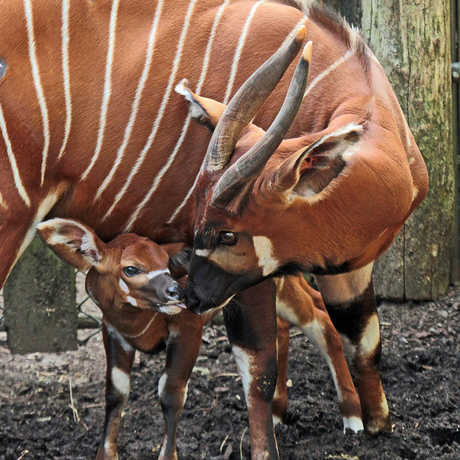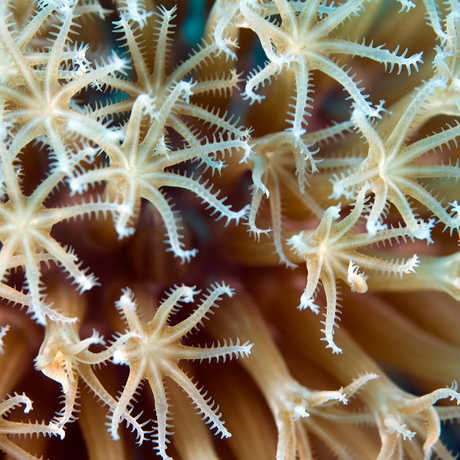
© Brocken Inaglory
Lots of animals live in the ocean - but they aren't all fish! In this lesson, students will learn the characteristics that make an animal a fish, create a model of a fish, and compare it to other marine animals to decide if they are fish or not.
In this lesson, students will:
- learn the characteristics of fish.
- create a three-dimensional sculpture.
- compare fish to other marine animals.
- clay (modeling clay that doesn’t harden)
- heavy cardstock (various colors)
- plastic straws
- metal brads or googly eyes
- toothpicks
- popsicle sticks
- pictures of marine animals (optional)
- gills: delicate, feathery structures that fish use to breathe
- scales: thin plates that cover and protect fishes’ bodies
- fins: flat body parts used for movement, steering, and balance
- backbone: the spine; the bony structure the runs from the bottom of our skull to our pelvis; animals with a backbone are called vertebrates
- Divide and roll clay into 1 1/2 inch diameter balls (1 per student).
- Cut straws in half so that you have two mini straws. Cut each mini straw in half lengthwise, so that each piece is only half a cylinder. You should have four straw pieces. Make enough for 1 straw piece per student.
- Cut heavy cardstock (older students may be able to do this part themselves). For each student you will need a piece of cardstock 1 inch by 2 inches. Cut it into 6 triangles as shown on page 2.
- Print out pictures of different marine animals to show students. You can use the ones included with this lesson or find you own images online. Be sure to include some oddly-shaped fish (like eels and stingrays) and non-fish marine animals (dolphins, sea stars, etc.).
- Ask students what they know about fish. Make a list of fish characteristics on the board.
- Show students pictures of fish. What body parts do all of these fish have? Draw a generic fish on the board so you can label the body parts that fish have:
- Scales
- Eyes
- Fins
- A mouth
- A gill slit
- Backbones are not visible, but include it in the list to help students remember that fish have them.
- Tell students that an animal must have these six characteristics to be a fish. Leave this list on the board for students to refer to.
- Depending on the needs of your class, you can either hand out all the materials to each student beforehand or pass them out at each appropriate stage. Each student will need:
- 1 ball of clay
- 2 google eyes or metal brads
- 5 heavy cardstock triangles (one of the large triangles is not needed)
- 1 straw piece
- 1 toothpick
- 1 popsicle stick
- Students will start with the ball of clay. Tell students that since they know the body parts of a fish, they will be working together to turn these clay balls into a school of fish. Ask students to look at their clay ball – is this the shape of a fish body? What shape could a fish’s body be? Have them shape their clay into a fish body. Elongated ovals work well, but round fish, square fish, or heart-shaped fish are ok too!
- Ask students “What else does our fish need to be a real fish?” Revisit the diagram on the board to decide what characteristic comes next. Use this question to guide the rest of the fish building. The steps on how to create the body parts are below and can be done in any order. Teacher tip: It’s tricky to do the scales with the eyes and fins already attached, so guide students into doing the scales first.
- Scales: Press one end of the straw piece into the clay body over and over to create scales.
- Eyes: Press google eyes or brads into the front of the fish for eyes.
- Tailfin: Press the largest cardstock triangle into the end of the fish for the tail.
- Fins: Press the other triangles into the body to make the other fins (one on the top, one on the bottom, and one on each side).
- Mouth and Gills: Use the toothpick to make a mouth and two vertical lines between the eyes and the side fins for gills.
- Backbone: We can’t see it from the outside, so remind students to imagine their fish having a skeleton on the inside. If there’s no backbone, it can’t be a fish!
- After the fish is complete, students press the popsicle stick into the underside of the fish. This allows them to hold onto the fish like a puppet and move it around like it is swimming.
- Consider passing out another small piece of clay to each student so that they can make a stand for the fish. Tell students to stick the bottom of their popsicle stick into a piece of clay on the table.
- Review what characteristics an animal needs to be a fish. Show students pictures of marine animals and have them decide if it is a fish or not by using their fish models for comparison. If they think it’s a fish, they can hold their fish puppet high in the air. Call on students to explain why the animal is or isn’t a fish.
- Discuss the following questions:
- Why do fish have scales? (for protection and to help maintain water balance inside the body)
- Why do fish have fins? (for swimming and balance)
- Are all our fish the same? (No, even though all our fish have the same parts, there is variation among our individual fish, just like in nature.)
- Have students write about their fish. They should include its name, a description, where it lives, and what it eats.
- Discuss how the shape and location of body parts affects how the fish lives. For example, if the mouth is on the bottom, the fish is likely a bottom feeder, eating organisms on the ocean floor. If the tail fin is short and V-shaped, it is a fast swimmer.
- Use this lesson as a pre-visit activity before a field trip to an aquarium. On the field trip, have students pay attention to which animals are fish and which animals live in the water but are not fish. This can be done verbally or with a scavenger hunt.
- This lesson is a good tie in to lessons about vertebrates versus invertebrates, and the five groups of vertebrates (fish, amphibians, reptiles, birds, and mammals).
There are more types of fish than all other groups of vertebrates combined - over 27,000 species have been described worldwide (Florida Museum of Natural History). With that many species, there is a lot of diversity. Fish come in many shapes and forms, with each adapted to their specific habitat and niche. Despite the diversity, all fish have these characteristics:
- a spinal column (they are vertebrates);
- scales covering their body;
- fins to help with movement;
- eyes;
- a mouth in the front of the body;
- gills to breathe with.
There are exceptions to these rules: hagfish are fish, but technically are not vertebrates (UC Berkeley), and different types of fish have different numbers of fins. Sharks are fish but they have some slight tweaks to these characteristics. Their scales are modified into structures called dermal denticles, protecting their skin with a rough texture. Bony fish, which are the focus of this lesson, have only one gill slit, or operculum, but sharks will always have five or more. Stingrays are related to sharks, making them fish as well.
Knowing what qualifies as a fish also helps us understand what sea creatures are not fish. Jellies and sea stars, often called jellyfish and starfish, are good examples. These invertebrates lack a spinal column, scales, fins, and a mouth in the front of the body, disqualifying them as fish (they do have gills, and some species of jellies and sea stars do have light sensing cells that allow them to detect light and dark, similar to an eye). We can also apply this to marine mammals. Sometimes whales and dolphins are mistakenly called fish. While they do have fins, eyes, a mouth, and a spinal column, they do not have scales or gills – marine mammals use lungs to breathe air, just like humans.
Kindergarten
Life Sciences
- 2a. Students know how to observe and describe similarities and differences in the appearance and behavior of plants and animals (e.g., seed-bearing plants, birds, fish, insects).
- 2c. Students know how to identify major structures of common plants and animals (e.g., stems, leaves, roots, arms, wings, legs).
Visual Arts
- 2.7 Create a three-dimensional form, such as a real or imaginary animal.
Grade One
Visual Arts
- 2.5 Create a representational sculpture based on people, animals, or buildings.
Grade Two
Life Sciences
- 2c. Students know many characteristics of an organism are inherited from the parents. Some characteristics are caused or influenced by the environment.
Scientific and Engineering Practices
- Developing and Using Models: Compare models to identify common features and differences.
Disciplinary Core Ideas
- LS4.D: Biodiversity and Humans: There are many different kinds of living things in any area, and they exist in different places on land an in water.
Cross-Cutting Concepts
- Patterns: Patterns in the natural and human designed world can be observed, used to describe phenomena, and used as evidence.
- Systems and System Models: Objects and organisms can be described in terms of their parts.
- Structure and Function: The shape and stability of structures of natural and designed objects are related to their function(s).
Related Performance Expectations
- 2-LS4-1: Make observations of plants and animals to compare the diversity of life in different habitats.
Florida Museum of Natural History, “Most Commonly Asked Fish Questions.” Retrieved on June 25, 2015.
UC Berkeley, University of California Museum of Paleontology. “Introduction to the Myxini.” Retrieved on June 25, 2015.


